|
A HISTORY OF LISNAGARVEY HOCKEY CLUB
1901-1976 by KENNETH H. HOOD, B.A., H.Dip.Ed.
PUBLISHED ON THE OCCASION OF THE 75th ANNIVERSARY
SEASON 1976- 77
Printed by Century Services Limited, Belfast
|
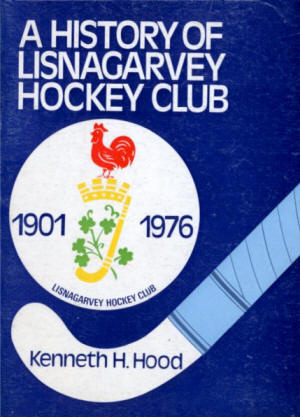 |
It gives me the greatest pleasure to write this foreword
to a unique book - "The History of the Lisnagarvey
Hockey Club" published on the occasion of the 75th
Anniversary of the Club.
Ken Hood has a long association with the Club and the
town of Lisburn. A former player with the 2nd XI and
Junior teams, he was Club Secretary for 16 years, and
for over 20 years he was Head of the History Department
at Wallace High School until he retired just two years
ago. Perhaps even more important, for many years he was
the Senior Sports-master at the school responsible for
cricket, rugby and hockey. It was he who so successfully
reintroduced hockey after many years lapse, and truly
laid the foundation of such a talented nursery for the
Lisnagarvey Club. What foresight Kenneth showed as
Wallace hockey has developed to stand alongside Friends
School, and give the town club a constant supply of some
of the provinces outstanding young players.
Many of the present administrators and players of the
club are products of Wallace High School and a Hood/
Lowry partnership. The current Club Secretary W. K.
Lowry was taught his hockey by Hood, captained the
school team and played with 'Garvey teams for almost
thirty years. He succeeded Hood as the Wallace hockey
coach and until recently, continued the solid
foundations laid down by his "master". Indeed this
publication was written by Hood whilst Lowry is
responsible for the production - a unique partnership
and a tribute to both men.
It is a truly marvellous record of a great club as
told by a devoted servant - congratulations Kenneth and
good luck to you, your proteges, and of course,
continued success to the Lisnagarvey Hockey Club.
William Bowden, Patron.

It is a great honour to be asked to write this short
history of the Lisnagarvey Hockey Club. My connection
with the club date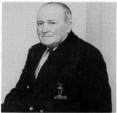 s from 1946 shortly after my release
from the Army. Later I acted as Honorary Secretary for
16 years. s from 1946 shortly after my release
from the Army. Later I acted as Honorary Secretary for
16 years.
Like a Dublin hockey fan who wanted to know what was
the little village near Belfast with the famous hockey
club, my knowledge of 'Garvey was rather limited until I
came to Lisburn. It was a club which won many trophies
and produced famous players like Gregor McGregor, Harry
Greenfield, and the Bowdens, but in the depths of my
ignorance I thought it was based in Belfast. For such
heresy my sincere apologies to the people of Lisburn
generally and to the members of Lisnagarvey in
particular.
In 1951 with the encouragement of the Headmaster, Mr.
T. C. C. Adam, and later with the help of Mr. George
Henry, I restored hockey in the Wallace High School. It
is a source of deep satisfaction that it developed into
a nursery, second only to Friends School, and also has
produced men like Jim Reid, John Waring, Billy Lowry and
Bobby Richardson who have contributed so much to the
club. Another outstanding player and administrator is
Bobby Howard but he had left school shortly before my
arrival.
Such a survey as this will possibly include errors
and omissions, and I crave the indulgence of anyone who
may be affected.

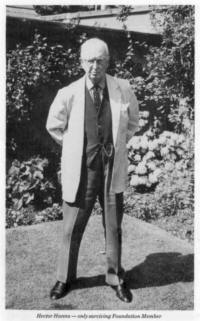 One evening in September, 1901, three young Lisburn men
met in the Lisburn Temperance Institute at the bottom of
Railway Street. They had an informal discussion about
sport in Lisburn, during which the idea of the formation
of a new hockey club was mooted. The three were W. S.
Duncan, E. E. Wilson and R. C. Bannister. During the
following weeks the opinions of other young men were
canvassed and before long a meeting was summoned to
discuss the project. That date is not known, as no
records seem to have been kept. It is known that it was
decided to form such a club to be known as Lisnagarvey,
the old name of Lisburn. R. C. Bannister was chosen to
be Captain, E. E. Wilson was elected as Hon. Treasurer
and W. S. Duncan, Hon. Secretary. One evening in September, 1901, three young Lisburn men
met in the Lisburn Temperance Institute at the bottom of
Railway Street. They had an informal discussion about
sport in Lisburn, during which the idea of the formation
of a new hockey club was mooted. The three were W. S.
Duncan, E. E. Wilson and R. C. Bannister. During the
following weeks the opinions of other young men were
canvassed and before long a meeting was summoned to
discuss the project. That date is not known, as no
records seem to have been kept. It is known that it was
decided to form such a club to be known as Lisnagarvey,
the old name of Lisburn. R. C. Bannister was chosen to
be Captain, E. E. Wilson was elected as Hon. Treasurer
and W. S. Duncan, Hon. Secretary.
The subscription for playing members was to be 5
shillings and for Vice-Presidents half a guinea. The
club colours would be light and dark blue. The original
members were W. S. Duncan, R. C. Bannister, B. Boyd, E.
Boyd, F. Garrett, R. V. Hamilton, Hector B. Hanna, J. G.
Hanna, N. G. Kilpatrick, E. S. H. Thompson, E. E.
Wilson, I. H. Wilson and J. H. Wilson. Later they were
joined by H. H. Burrowes, H. E. Gamble, S. McMurray, V.
McMurray, G. McGrath, D. McCartney and R. Rainey. The
only survivor of that august band is Mr. Hector Hanna,
now living in retirement in Dundalk. Not in their
wildest dreams could the twenty-odd young men have
realized that from these modest beginnings was to emerge
what was to become Ireland's most famous hockey club. It
was not the first hockey club to be formed in the town.
That distinction belonged to the Lisburn Hockey Club
founded in 1897.
Their playing headquarters were on the Magheralave
Road at what is now the Friends School rugby pitch. This
ground was later taken over by Lisnagarvey and was
occupied by them until the mid-thirties. The Lisburn
colours were green, old gold and black. Their President,
Dr. Keightley in 1899 presented a cup to the Ulster
Branch, first won by North Down and now presented to the
winners of the Senior League. In 1900 one of their
players, 1. F. Robinson, was selected at full-back for
Ulster. They were very much the premier Lisburn team, as
Lisnagarvey started in the minor ranks, while Lisburn
had achieved senior status.
During their first full playing season, 1902-03,
'Garvey played only friendly matches with considerable
success, the score against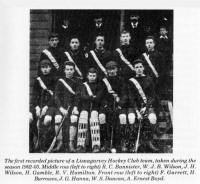 Holywood being 15-0. Their
most prized success was over local rivals Lisburn 2nd's
by 2-1, but games against Cliftonville and Newtownards
were lost. A ground was obtained on the Magheralave
Road, by the good offices of Mr. J. A. Wilson. The
infant club seems to have had its share of teething
troubles. Quite a few of the original members were
either expelled or "compulsorily retired", the
difference is not immediately apparent. This was for
various misdemeanours. Indeed it is ironic that in a
Club, the name of which, from the Gaelic, means the
"fort of the gamesters", any form of gambling, however
innocent, was severely frowned on. The power of the
committee was limited, and much of the routine business
was transacted at a series of special general meetings.
Members of Committee were sometimes fined for failure to
carry out directives. In the opening season there was a
reshuffle
with R. C. Bannister resigning the Captaincy and being
replaced by W. S. Duncan, Mr. Bannister became Secretary
and when E. E. Wilson was expelled he was replaced by J.
H. Wilson as Treasurer. In the following year the entire
Committee was censured at a Special Meeting and replaced
by a complete new Committee. These internal squabbles
led to a breakaway of a few members to join the rival
and now Senior Lisburn Club, and relations between the
two were rather strained. There is a story that on one
occassion two 'Garvey members encountered two of their
rivals near the drinking fountain in the Wallace Park.
High words ensued until one of the 'Garvey pair asked
his friend to hold his cuffs while he dealt summarily
with the opposition. Holywood being 15-0. Their
most prized success was over local rivals Lisburn 2nd's
by 2-1, but games against Cliftonville and Newtownards
were lost. A ground was obtained on the Magheralave
Road, by the good offices of Mr. J. A. Wilson. The
infant club seems to have had its share of teething
troubles. Quite a few of the original members were
either expelled or "compulsorily retired", the
difference is not immediately apparent. This was for
various misdemeanours. Indeed it is ironic that in a
Club, the name of which, from the Gaelic, means the
"fort of the gamesters", any form of gambling, however
innocent, was severely frowned on. The power of the
committee was limited, and much of the routine business
was transacted at a series of special general meetings.
Members of Committee were sometimes fined for failure to
carry out directives. In the opening season there was a
reshuffle
with R. C. Bannister resigning the Captaincy and being
replaced by W. S. Duncan, Mr. Bannister became Secretary
and when E. E. Wilson was expelled he was replaced by J.
H. Wilson as Treasurer. In the following year the entire
Committee was censured at a Special Meeting and replaced
by a complete new Committee. These internal squabbles
led to a breakaway of a few members to join the rival
and now Senior Lisburn Club, and relations between the
two were rather strained. There is a story that on one
occassion two 'Garvey members encountered two of their
rivals near the drinking fountain in the Wallace Park.
High words ensued until one of the 'Garvey pair asked
his friend to hold his cuffs while he dealt summarily
with the opposition.
Finance, or the lack of it, was another problem.
There is a tradition that some committee meetings were
held in the waiting room at Railway Street Station,
hardly with the approval of the Great Northern Railway.
Still another special meeting decided to augment club
funds by imposing an admission charge of one penny.
Later several members were appointed as stewards to
ensure that spectators did not dodge their
responsibilities.
In the same year a move was made further down the
Magheralave Road to a field owned by Mr. Watson, and
afterwards another ground was obtained off the Antrim
Road, the property of Mrs. Norwood, at what is now
Bellevue Drive. This pitch was later used by South
Antrim Ladies and the girls of Wallace High School. A
pavilion was erected by the members themselves. It was
decided to lay a cinder floor, and to erect a flag pole.
Toilet facilities were provided to the extent of two
basins, two mirrors, soap and towel. It was also
proposed to paint the pavilion but this was thought to
be too costly and instead it was to be coated with Halls
Distemper, the cost not to exceed five shillings.

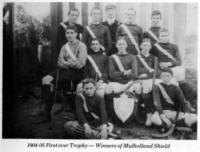 In 1903-4 the club made its first appearance in
competitive hockey in the Minor League. They won 11 out
of 16 league matches. In the following year came greater
success with an unbeaten league round to capture the
Mulholland Shield, the first ever trophy. It was out in
display in the premises of Mr. H. Kirkwood one of the
Vice-Presidents. In addition they reached the Final of
the Minor Cup defeating Monaghan in the Semi-final but
losing to Downpatrick at Cliftonville. The successful
team was: W. J. Wilson; H. B. Hanna; B. Boyd; A.
McCluggage; A. T. Annesley; J. H. Wilson; A. E. Boyd,
(Capt.); F. G. Hull; R. C. Bannister; J. H. Simpson and
N. B. Kilpatrick. In 1903-4 the club made its first appearance in
competitive hockey in the Minor League. They won 11 out
of 16 league matches. In the following year came greater
success with an unbeaten league round to capture the
Mulholland Shield, the first ever trophy. It was out in
display in the premises of Mr. H. Kirkwood one of the
Vice-Presidents. In addition they reached the Final of
the Minor Cup defeating Monaghan in the Semi-final but
losing to Downpatrick at Cliftonville. The successful
team was: W. J. Wilson; H. B. Hanna; B. Boyd; A.
McCluggage; A. T. Annesley; J. H. Wilson; A. E. Boyd,
(Capt.); F. G. Hull; R. C. Bannister; J. H. Simpson and
N. B. Kilpatrick.
The season saw the foundation of a Ladies Section and
in their first year the Ladies won the Junior League
title. Their subscription was fixed at half-a-crown. For
the next few years a running fight developed between the
Ladies Branch and a section of the Men's Club. Could it
have been that this was the era of the Women's Suffrage
Movement and that certain "Male Chauvinist Pigs"
believed that females should be kept firmly in their
places! However, every year, and in some, more than one
attempt was made to get rid of them. A proposal was made
to stop all mixed matches and the campaign culminated in
a motion in 1906 that the Ladies Club be forthwith
"exterminated or dissolved". This drastic measure failed
to reach the necessary majority as did another to expel
their main officials. After this relations seemed to
improve although the Captain and another official were
expelled later for failure to carry out club policy.
Nevertheless, there is no doubt that the Ladies played a
big part in club development, particularly in the
raising of funds. This is clearly shown by the effort to
keep the Ladies Branch in being in later years when it
seemed likely to fold up, and also the paramount part
the women played in the Bazaar of 1910, and by its
reformation after the war.
After the initial success the club was accepted into
Junior League circles in 1905-6 and made its debut in
the Irish Junior Cup. They won 11 of its League matches
and reached the final of the Irish Cup. So great was the
enthusiasm that Wallace Duncan came back specially from
Manchester to play in the Semi-final against East
Antrim.
The final was played at the Leinster C.C. against
Monkstown. 'Garvey established an early two goal lead
through Hanna and Bannister, but Monkstown rallied in
the second half and equalized just on time. There was no
score in extra time, but the much more experienced
Dublin side made no mistake in the replay winning by
5-0. The 'Garvey XI was H. Simpson; F. G. Hull; J. H.
Wilson; W. S. Duncan; F. Hatch; A. McCluggage; H. H.
Burrows; R. C. Bannister; E. Boyd; H. B. Hanna; B. Boyd.
Incidentally it was nearly half a century before
Lisnagarvey eventually won this important trophy, a
competition which has been dominated by the 2nd XI over
the past two decades.
Season 1906-7 was even more successful. Under J. H.
Wilson the Junior League was won with only one defeat by
a team called Silverstream. Even more important, the
Braddell Shield also came to Lisburn. In the semi-final,
they just got the better of Silverstream after a replay,
and in the Final they disposed of Downpatrick 2nd XI.
Senior status was achieved in the next year, a
remarkable rise in only five years. With a membership of
60, the Club could now field three elevens although the
Thirds played only friendly matches. Success breeds
success, as in the previous year it had been difficult
to field a Seconds side. Then came another milestone in
Club history, after being selected as substitute Fred
Hull was capped against Wales, his first cap, and the
first won by a 'Garvey player. The 1st XI cut little ice
in the Senior League. In 1909-10 they entered for the
Irish Senior Cup but were routed by Queens' University.
They did succeed in drawing a League match at Banbridge
and it became one of their major ambitions to beat "the
Bann".
This was not achieved until after the war but there
were a few near misses. In 1908 the total income of the
Club had been �14 and, it is not surprising that there
was opposition to spending as much as �8 on drainage and
even on such things as goal nets. As there had
been a considerable divergence in the colours and type
of gear worn by players it was laid down as a strict
rule that the outfit should consist of dark blue shirts
with light blue collars and pockets, dark and light blue
belts and blue topped stockings. In October 1910 came
the first major fund raising effort. In conjunction with
the Lisburn Cricket Club, a Bazaar was held which
benefited 'Garvey to the extent of �94.15.5d. a very
substantial sum which put the finances on a firmer
basis. As already mentioned the Ladies Branch played a
big part in the effort. The amounts raised were:

| Refreshments: |
�30. 11. 6d. |
| Provisions: |
�13. 0. 0d. |
| Stalls 1 and 2 . |
�65. 5. 5d |
| Bric-a-Brae (Including book
of sport) |
�64. 0. 4d. |
| Excelsior Stall: |
�48. 2. 2d. |
| Subscriptions: |
�20. 9. 4d. |
| Total: |
�239. 8. 9d. |

In this year Lisburn Hockey Club ceased to exist and
Lisnagarvey acquired their ground in the Magheralave
Road at Friends School.Although the Antrim Road pitch
was retained, the cost of maintaining two pitches put a
heavy burden on Club finances.
Season 1908-9 saw the first cross channel tour to
Llandudno and Chester. These tours became a feature of
Club life with visits to Glasgow and Edinburgh in
successive years and to Manchester and Chester in
1913-14. So for the first time the name of Lisnagarvey
became known across the water as the touring sides met
with considerable success against top class sides such
as Cartha and Rutherglen. In 1909 mainly due to the work
of J. G. Hanna a Debating Society was formed as a
subsidiary activity but it must have had a rather short
life.
Although the 1st XI failed to win any trophies in the
pre-war period, the Junior 3rd XI won the Mulholland
Shield in 1910 and the 2nd XI annexed the Braddell
Shield in 1912-13 when the 1st XI finished third in the
Senior League, the highest place yet achieved. In 1914
they reached the Final of the Kirk Cup in which they
drew 1-1 with Banbridge and lost a hard fought replay by
only 3-2, the nearest yet to that long awaited success
against their greatest rivals. As early as 1908 a
juvenile team had been formed. It is interesting to look
at the names. In addition to Skipper F. Allan the other
members were George Bannister, F. Rice, S. Kilpatrick,
Q. Dunlop, C. Carson, N. Russell, John Wilson, William
Wilson, Tom Malcolmson and Charles Garrett. Among these,
many were to figure in the First World War and in the
success of the Club after the "War".
In studying the history of the early period, certain
names keep re-occurring in every aspect of club
activity, particularly such as R. C. Bannister, J. H.
Wilson, A. E. Boyd, F. Hull, W. S. Duncan, R. V.
Hamilton, and the brothers Hector and Jim Hanna. During
the second decade there emerged the names of men like
Fred Rice, George Bannister and Ernest Browne. These
were the men who by their hard work and devotion guided
the Club through its early formative period and the
difficulties of World War I. What is even more important
is that it was they who did so much to build up and
firmly establish what is called the "Garvey Tradition"
which has persisted down the years. Naturally, as time
went on most of the original and early members dropped
out, some due to death, others left the district, and
others when they grew older no longer took the same
active interest in the Club. Four of those Gentlemen
continued to take such an interest throughout the whole
of their lives until their deaths in very recent times.
First there was R. V. Hamilton an original member,
Captain of the 1st XI, administrator in various offices
and finally Patron of the Club until his death. A quiet
man, of keen intelligence with a remarkable sense of
humour, he was regarded with deep affection and respect
by all who knew him. Then there was his close friend,
James G. Hanna who also served the Club in various
capacities and was for many years President. When he
relinquished this post he remained a Trustee and his
advice was often sought on financial matters. Of a very
different temperament to Mr. Hamilton, he will be
remembered for his frank speaking.
The name of Ernest Browne ranks very high. He too
captained the 1st XI, was a highly efficient Secretary
and a member of the famous team of the 1920's. His
career was cut short by illness, but on his return to
Lisburn he will be remembered for his generosity and
interest in the progress of the Junior teams and
members. He was a conscientious Justice of the Peace. As
a member of the Board of Governors of the Wallace High
School, he encouraged the growth of hockey and cricket
in the School and was a great help-to me in both School
and Club affairs.
Finally, there was his contemporary George Bannister
who held all the important positions including Captain
and was both an international player and umpire. In
later years ill health prevented him taking as much
active interest as he would have wished but that
interest remained until his death and even beyond,
because the Club benefited from a legacy in his will.
 |